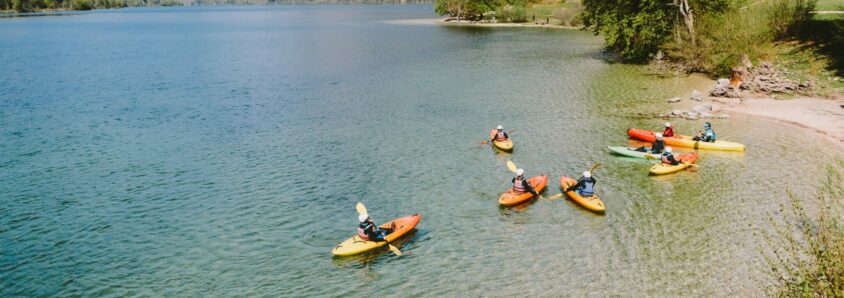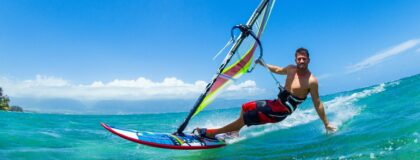Before we get into our risk management tips for guided kayaking tours, did you know Prime Insurance Company provides SMART solutions for guided kayaking tours? Your client can get insurance coverage that actually covers them, including:
- Commercial general liability
- Professional liability
- Inland marine coverage
- Alleged assault and battery liability
- Alleged sexual abuse and molestation liability
- TRU Umbrella
- And more!
As an insurance producer, you have a vital role in helping your clients manage risks and protect their businesses. Guided kayaking tours offer adventure-seekers the opportunity to explore new waters with the guidance of experienced professionals. However, these tours come with unique risks and challenges that need to be properly managed. By sharing these in-depth risk management tips with your clients, you can help them provide a safe and enjoyable experience for their customers while minimizing potential liabilities.
5 Risk Management Tips for Guided Kayaking Tours
- Thoroughly Vet and Partner with Experienced Guides
The success and safety of guided kayaking tours heavily rely on the expertise and experience of the guides. Advise your clients to thoroughly vet and partner with guides who have extensive knowledge of the specific waters where the tours are conducted. Experienced guides should be well-versed in assessing tidal patterns, currents, potential hazards, and prevailing weather conditions. They should also have strong navigation skills and be familiar with emergency procedures. Encourage your clients to ask for references and conduct thorough background checks on potential guides to ensure they meet the necessary qualifications and have a proven track record.
- Implement Comprehensive Safety Training and Briefings
Prior to any guided kayaking tour, a comprehensive safety training session and briefing should be conducted for all participants. Work with your clients to develop a detailed training program covering critical topics such as:
- Proper Paddling Techniques: Educate participants on efficient strokes, maintaining balance, maneuvering, and how to paddle in varying conditions such as calm waters, currents, and waves.
- Water Safety Rules: Emphasize the importance of wearing personal flotation devices (PFDs), staying within designated areas, and respecting the natural environment. Instruct participants on how to navigate safely and avoid potential hazards.
- Communication Signals: Teach participants common communication signals to ensure effective communication between guides and participants during the tour. These signals should include warnings, instructions, distress signals, and calls for assistance.
- Emergency Protocols: Develop and practice emergency protocols for various scenarios such as capsizing, equipment failure, or injuries. Make sure participants understand how to respond, offer immediate aid, and contact emergency services if needed.
- Insist on High-Quality Safety Equipment
For risk management purposes, it is crucial that your clients provide participants with reliable and high-quality safety equipment. Advise them to invest in the following items:
- Personal Flotation Devices (PFDs): Require participants to wear properly fitting PFDs approved by relevant authorities. Regularly inspect and maintain the PFDs to ensure they are in good condition.
- Helmets: In areas with potential head injury risks, such as rapids or whitewater kayaking sites, strongly encourage the use of helmets by participants.
- Spray Decks: If the guided tours involve kayaking in open waters or areas prone to water splashes, spray decks provide additional protection against water entering the kayak.
- Rescue Gear: Equip guides and staff with essential rescue gear such as throw bags, tow systems, and signal devices. These tools are essential for swift and effective response to emergencies.
Regularly inspect and maintain all safety equipment to ensure it remains in optimal condition.
- Develop and Practice Emergency Response Plans
Having well-developed and practiced emergency response plans is critical for ensuring the safety of participants. Work closely with your clients to establish protocols for various emergency scenarios and train guides and staff on how to respond calmly and effectively. Key elements to include in emergency response plans:
- Medical Emergencies: Train guides in basic first aid techniques and CPR. Establish communication protocols to contact emergency medical services promptly.
- Capsizing or Equipment Failure: Instruct guides on how to assist participants in reentering the kayak safely after a capsize. Develop protocols for equipment failure, including how to handle malfunctioning kayaks or paddles.
- Communication and Coordination: Establish clear communication channels to relay emergency situations to the necessary parties, including emergency services and base camps. Determine evacuation routes in case immediate medical attention is required.
Testing and practicing emergency response plans through simulations and drills will help ensure smooth execution during critical situations.
- The Importance of Liability Insurance for Guided Kayaking Tours
Lastly, emphasize to your clients the necessity of having proper liability insurance coverage. Accidents and injuries can occur during guided kayaking tours, potentially leading to costly legal actions. By partnering with Prime Insurance Company, you will have access to an excess and surplus lines insurance carrier that provides liability insurance to guided kayaking tours. We are rated “A” (Excellent) by A.M. Best, as we provide reliable coverage and support to guide your clients through potential liability claims.
Share Our Top Kayaking Risk Management Tips With Your Clients!
By implementing these in-depth risk management tips, your clients can help ensure the safety of participants during guided kayaking tours. Encourage your clients to develop comprehensive safety procedures, vet experienced guides, provide high-quality safety equipment, and have adequate liability insurance coverage. By taking these measures, they can minimize risks, protect their businesses, and offer customers a safe and memorable kayaking experience.
Go to https://www.primeis.com/quotes/ to find out how you can get a quote or call 800-257-5590 to speak with an underwriter today!


